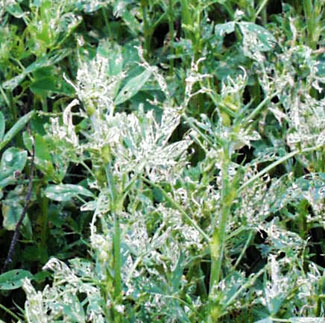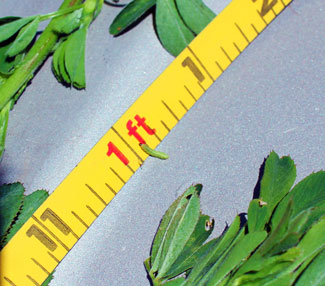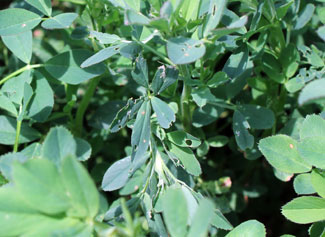Alfalfa weevil pressure in alfalfa stunted by frost injury
Scouting fields for alfalfa weevil on a regular basis is critical for this year’s first cutting.
The concern of alfalfa producers as to whether they should cut their frost-damaged alfalfa fields will be a point of history if alfalfa weevil is present in large enough numbers to be over economic threshold. As of May 15, the estimates for southern Michigan are that 70 percent of alfalfa fields have been cut and any alfalfa weevil levels will be decreased significantly. In the Thumb region, several fields scouted May 14 were at a 40-percent leaf tip feeding level. However, much of the alfalfa in the Thumb, northern Michigan and the Upper Peninsula is still too immature to be cut, so scouting is critical to insure producers aren’t caught by surprise.

Heavily damaged alfalfa due to alfalfa weevil
Alfalfa weevil is a common insect and occasionally an economic pest. Adults overwinter in areas such as fields, fence rows or woodlots. Adults will feed on new growth and lay eggs in holes chewed into the stem. The adult is a gray-brown snout beetle and has a dark stripe down its back; the larvae are green with a white stripe down its back and have a black head. Size generally ranges between 0.25 and 1 inch long. As the size of the larvae increase, the amount of leaf feeding increases, leaving skeletonized leaves. Larvae pupate in cocoons on plants and emerge as adults in mid-June and July, feed a short time and then become inactive until the following spring. There is one generation per year.

Small alfalfa weevil
larvae

Alfalfa weevil larvae
Several species of parasitoid wasps are very effective as a biological control against alfalfa weevil. However, there are years when alfalfa weevil will not be controlled by the natural enemies.
To scout for larval feeding before first cutting, sample 20 stems in five different locations in the field, and look for larvae and damage. The threshold is 40 percent of stems damaged (showing leaf feeding) and have larvae present.

Tip feeding by
alfalfa weevil larvae
Recently, a team of MSU Extension educators have been taking scissor cuttings from alfalfa fields to determine the neutral detergent fiber levels and provide guidance as to when to cut first cutting. To view the findings from the week of May 7-8, see 2012 Field Project: Impact of Spring Weather on Alfalfa Quality – week of May 7th sample results.
If it is less than seven or more days before cutting, consider a spray treatment. If it is less than seven days before cutting, then cutting early to avoid spraying is a good management option. Remember to check regrowth for weevil damage.
If fields are sprayed for weevil, remember to pay attention to pre-harvest intervals (PHI). Many insecticide products have PHI labels of seven or more days.



 Print
Print Email
Email




